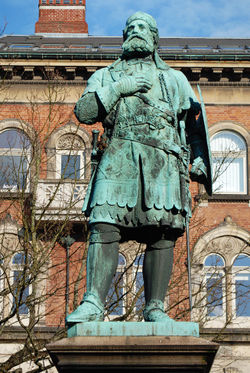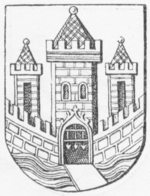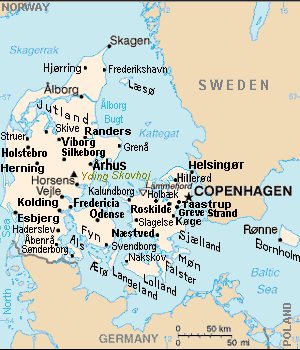Randers



Randers (Danish pronunciation: [ˈʁɑnɐs]) is a city in Randers municipality (Aarhus County, Region Midtjylland) on the Jutland peninsula in central Denmark. It is Denmark's sixth-largest city, with a population of 60,227 (1 January 2010)[1]. It is the main town of the municipality and the site of its municipal council.
Randers municipality has 94,750 inhabitants (2010). The municipality is also a part of the East Jutland metropolitan area, which has 1.2 million inhabitants. [2].
Randers, Denmark's only natural river harbour, is on the banks of the River Guden (Gudenå), about 6 miles (10 km) above its mouth in Randers Fjord, and 111 miles (179 km) west-northwest of Copenhagen. This location has had great significance for trade by sea. Barges on the Guden River and the Northern River (Nørreå) transported goods into Randers from Silkeborg and Viborg for export. In return, came imported items.
A vast agricultural area, and good transportation by land and by water, helped make Randers a dynamic center for trade and commerce. Known for the many access roads leading into the city, it has engendered the popular saying, "Where the waterway meets the 13 highways" ("Hvor søvejen møder de 13 landeveje").
Randers is referred to as Crown Jutland (Kronjylland) and the people as Crown Jutlanders (Kronjyde), probably due to the big Crown estates owned by the King. The term Kronjyde was first used by Danish poets around 1750. Nicolai Frederik Severin Grundtvig (1783–1872) and Hans Christian Andersen (1805–1875), and especially Nobel Prize laureate Henrik Pontoppidan (1857–1943), used the term.
Contents |
History
Randers was formally established around the 12th century, but traces of a population have been discovered dating back to Viking times.
Canute IV of Denmark (ca. 1043–1086), also known as Canute the Saint and Canute the Holy, and as patron saint of Denmark, minted coins in the town. The peasants of Randers who rose up against him and his plans to attack England and its ruler, William the Conqueror, assembled in this town. Their uprising led to the death of Canute.
The town was fortified through much of the Middle Ages. Today, however, the only sign of defensive walls is their existence in street names. These streets follow a circular path, presumably following the location of the historic walls. Street names include Østervold ("Eastern Defense Wall), Nørreport ("Northern Gate"), Vestervold ("Western Defense Wall), and Lille Voldgade (Little Defense Wall Street").
A chronicle written at Essenbæk Cloister tells of a fire that ravaged the city. The city was destroyed and rebuilt three times in the 13th century. In 1246, it was burned down by Abel of Denmark's troops during the civil uprising against Eric IV of Denmark.
On a street in the town center is the house where, according to legend, Danish nobleman and national hero Niels Ebbesen killed Count Richard (Gerhard) III of Holstein on 1 April 1340, during the Kingless Times, when the entire country was pledged to German counts. This action led to further insurrection against the Germans. Ebbesen died in a large battle at Skanderborg Castle (Skanderborg Slot) in December 1340. A statue to Ebbesen stands in front of Randers' Town Hall today.
When King Valdemar IV of Denmark (Valdemar Atterdag) tried to assemble a government in 1350 after the mortgaging to the Holsteiners, the town was further reinforced with protection, and was often named as Randershus ("Randers Fortress"). This fortification was captured by dissatisfied nobility in 1357. In 1359 Valdemar attacked the captured city with the strength all of his forces.
In 1534 a farmers' uprising tried to storm the town unsuccessfully. Massive moats were set up around the town under the rule of King Christian III (1536–1559).
During its peak there were almost 170 merchants' estates in the area, and a sizeable navy that sailed around the world. Some of these old half-timbered estates and manor homes can still be seen in the town.
According to "The Popular Encyclopedia; or, Conversations Lexicon", Blackie & Son c 1890, it contained at that time an arsenal, a classical school with six professors, and had several industrial establishments, including manufactures of gloves, for which it had long been famous. The town was also known for salmon, rope, and pretty women.
The harbour near the town had only 71⁄2 feet (2.3 m) of water, but there was a good shipyard; and at some distance below, at the mouth of the fjord, there was another harbour with 9 to 10 feet (3.0 m) water, and roads with good anchorage in 4 to 5 fathoms (24 to 30 ft; 7 to 9 m). Randers was important militarily, and could encamp from 10,000 to 15,000 men in the town and its neighbourhood, in a position which could not easily be over-run. The population in 1880: 13,457.
Today
The municipality was managed for almost 100 years by Social Democrats, until the Liberal Party's (Venstre) Michael Aastrup Jensen took over political leadership in 2002. Jensen, who was 25 years old at the time, distinguished himself as Denmark's youngest mayor ever. Since 2007, the city has again been ruled by Social Democrats.
The town has had its share of problems in recent years before the political power switch, including problems with motorcycle gangs and municipal administration scandals.
The city's football team, Randers FC ("Randers Football Club"), plays in Denmark's first league, the SAS Liga (Superligaen).
Twin towns
Attractions
Randers Tropical Zoo is Northern Europe's largest artificial rainforest, featuring about 350 different kinds of plants and more than 175 species of animals, many of which roam free under its three geodesic domes: the South America Dome, the Africa Dome, and the Asia Dome. Additionally there are areas called "The Snake Garden" and the Aquarium. The organisation has been involved in the restoration of local wetlands in Vorup Meadow (Vorup Enge), a large nearby area on the southwestern side of the Guden River.
Other attractions
- Randers Art Museum
- Museum of Cultural History
- Kejsergården
- Clausholm Castle
- Underværket, an innovative multi-ethnic business and cultural center
- Saint Mortens Church – 15th Century building
See also
- Chronicle of the Expulsion of the Grayfriars#Chapter 8 Concerning the Friary at Randers
References
- ↑ BEF44: Population 1st January, by urban areas database from Statistics Denmark
- ↑ [1]
- Attribution
![]() This article incorporates text from a publication now in the public domain: Some information extracted from "The Popular Encyclopedia; or, Conversations Lexicon", Blackie & Son c 1890.
This article incorporates text from a publication now in the public domain: Some information extracted from "The Popular Encyclopedia; or, Conversations Lexicon", Blackie & Son c 1890.
External links
- Official municipality website (Danish only)
- Randers tourism bureau
- Randers Rainforest website
- Randers Art Museum
- English Online Information about Randers
- (Sct. Morten's Church website, in Danish only)
|
|||||||||||||||||
|
|||||||||||||||||||||||||||||||||||||||||||||||||||||||||||||||||||
|
|||||||||||||||||||||||||||||||||||||||||||||||||||||||||||||||||||||||||||||||||||||||||||||||||||||||
